Improvements in the Surface Integrity and Operating Behaviour of Metal Components Through Slide Burnishing with Non-Diamond-Based Deforming Elements: Review and Perspectives
Abstract
1. Introduction
2. The Essentials of SB
2.1. Mechanics of the Deformation Process
2.2. Kinematic Schemes of SB Processes
2.3. SB Devices and Deforming Elements
2.4. Governing Factors
2.5. SB Processes Depending on the Burnishing Conditions
3. Conventional SB
3.1. Effects on SI
3.2. Effects on Operating Behaviour
4. Sustainable SB Processes
4.1. Dry SB
4.2. Cryogenic-Assisted SB
5. Minimum Quantity Lubrication-Assisted SB
5.1. Effects on SI
5.2. Effects on the Operating Behaviour
6. Special SB Processes
6.1. Effects on SI
6.2. Effects on Operating Behaviour
7. Hybrid SB Processes
8. Combined Processes Involving SB
9. Finite-Element Simulations of SB Process
10. Theoretical Investigation of the SB Process
11. Conclusions and Perspectives Concerning SB Processes
- There is a lack of information on the SB of super-alloys (for instance, GH4169, Inconel 718), bronzes, wear-resistant (manganese [Mn]) steels and cast iron alloys. Very few studies have been devoted to titanium (Ti) alloys. There has also been little research on the effects of SB on the SI and operating behaviour of cooper-based alloys. There is a lack of research on the SB of additively manufactured materials. Filling these gaps would be a promising direction for the development of SB.
- Given the very small number of studies, a promising direction is the SB of holes and flat and complex surfaces.
- The effects of SB on the SI of materials have been studied significantly more than the effects of this process on the operating behaviour of the machined component. The simple correlation between the SI and the operating behaviour has been studied much less frequently (the fewest studies were those focused on fatigue behaviour). Only one study investigated the SB–SI–operating behaviour correlation. Establishing this complete correlation is a prerequisite for developing cost-effective SB processes based on optimisation procedures for a specific material and application. The implementation of this integrated approach will improve the cost/quality ratio, providing added value.
- Sustainability issues are becoming increasingly important in all industries. Our review showed that SB is no exception to this trend, given the harmful effects of CFs (used in conventional SB) on human health and the environment. Expanding this research to include more materials is a particularly promising direction. For a process to be sustainable, it must fulfil three key demands–economic, environmental and social. Therefore, dry, cool-assisted and cryogenic-assisted SB processes are sustainable. The use of MQL partially reduces pollution and lubrication costs, but does not improve working conditions (the social aspect), due to the oil mist formed during its application, which cannot be completely eradicated and is the cause of numerous diseases. Therefore, the MQL-assisted SB process cannot be classed as a sustainable SB process because it occupies an intermediate (hybrid) position between conventional and sustainable processes.
- Hybrid and combined SB processes have significant potential for achieving a synergistic effect to improve the SI and operating behaviour of metal components. Particularly promising are the processes that combine thermal and chemical diffusion and SB, or the effects of concentrated energy flows (electron beam, laser beam and others) and SB. Such approaches combine the advantages of two effects—transformation hardening and strain hardening. As of writing, no such studies are available. Filling this gap will significantly expand the area of SB applications.
- Hybrid processes require simultaneous impacts on the treated surface, one of which has a dominant role (surface cold working), while the others perform an assisting function. So far, hybrid SB processes have been limited to the ultrasonic-assisted and cryogenic-assisted types. The development of hybrid SB processes to help with other types of assisting impacts (e.g., laser-assisted SB) will have useful scientific and practical ramifications.
- The development of super-hard materials for the manufacture of deforming elements, and the study of their tribological behaviour (as pairs with counterbodies made of different materials) is a prerequisite for expanding the scope of application of SB processes.
- The level of development of modern information technologies allows the use of artificial intelligence and machine learning to optimise and synthesise new SB processes.
- Given the increasing application of additively manufactured and composite structures, another perspective is the optimisation of existing and new SB processes in connection with modelling the mechanical behaviour (including fatigue) of such structures.
Author Contributions
Funding
Institutional Review Board Statement
Informed Consent Statement
Data Availability Statement
Conflicts of Interest
Abbreviations
| CF | cutting fluid |
| CNC | computer numerical control |
| FE | finite element |
| FEM | finite-element method |
| MQL | minimum quantity lubrication |
| RB | roller burnishing |
| SB | slide burnishing |
| SE | surface engineering |
| SI | surface integrity |
| SL | surface layer |
| SMB | spherical motion burnishing |
| SRB | slide roller burnishing |
| TSB | turning and slide burnishing |
| WC | tungsten carbide |
References
- Dwivedi, D.K. Surface Engineering. In Enhancing Life of Tribological Components; Springer: New Delhi, India, 2018; ISBN 978-81-322-3779-2. [Google Scholar]
- Miranda, R.M.; Gabdra, J.; Vilaca, P.; Quintino, L. Surface Modification by Solid State Processing; Elsevier: Amsterdam, The Netherlands; Woodhead Publishing: New Delhi, India, 2018; ISBN 978-0-85709-469-8. [Google Scholar]
- Burakowski, T.; Wierzchon, T. Surface Engineering of Metals: Principles, Equipment, Technologies; CRC Press: Boca Raton, FL, USA, 1998; ISBN 0-8493-8225-4. [Google Scholar]
- Plaster, H.J. A tribute to Benjamin Chew Tilghman. In Proceedings of the 5th International Conference on Shot Peening, Oxford, UK, 13–17 September 1993; pp. 2–9. [Google Scholar]
- Lawerenz, M. Shot Peening and its Effect on Gearing. In SAE Technical Paper 841090; SAE Mobilus: Warrendale, PA, USA, 1984. [Google Scholar] [CrossRef]
- Yang, J.M.; Her, Y.C.; Han, N.; Clauer, A. Laser shock peening on fatigue behavior of 2024–T3 Al alloy with fastener holes and stopholes. Mater. Sci. Eng. A 2001, 298, 296–299. [Google Scholar] [CrossRef]
- Soyama, H. Cavitation peening: A review. Metals 2020, 10, 270. [Google Scholar] [CrossRef]
- Soyama, H. Oxidation-induced stacking faults introduced by using a cavitating jet for gettering in silicon. Electrochem. Solid-State Lett. 1999, 3, 93–94. [Google Scholar] [CrossRef]
- Wegener, T.; Wu, T.; Sun, F.; Wang, C.; Lu, J.; Niendorf, T. Influence of surface attrition treatment (SMAT) on microstructure, tensile and low-cycle fatigue behaviour of additively manufactured stainless steel 316L. Metals 2022, 12, 1425. [Google Scholar] [CrossRef]
- Galda, L.; Koszela, W.; Pawlus, P. Surface geometry of slide bearings after percussive burnishing. Tribol. Int. 2007, 40, 1516–1525. [Google Scholar] [CrossRef]
- Hull, E.H.; Nerad, A.J. Irregular Diamond Burnishing Tool. U.S. Patent 2966722, 3 January 1961. [Google Scholar]
- Maximov, J.T.; Duncheva, G.V. Effects of diamond burnishing on surface integrity, fatigue, wear, and corrosion of metal components—Review and perspectives. Int. J. Adv. Manuf. Technol. 2025, 139, 4233–4267. [Google Scholar] [CrossRef]
- Korzynski, M. Slide diamond burnishing. In Nonconventional Finishing Technologies; Korzynski, M., Ed.; Polish Scientific Publishers PWN: Warsaw, Poland, 2013; pp. 9–34. [Google Scholar]
- Maximov, J.; Duncheva, G. The Correlation between Surface Integrity and Operating Behaviour of Slide Burnished Components—A Review and Prospects. Appl. Sci. 2023, 13, 3313. [Google Scholar] [CrossRef]
- Yen, Y.C.; Sartkulvanich, P.; Altan, T. Finite element modeling of roller burnishing process. CIRP Ann.-Manuf. Technol. 2005, 54, 237–240. [Google Scholar] [CrossRef]
- Nestler, A.; Schubert, A. Effect of machining parameters on surface properties in slide diamond burnishing of aluminium matrix composites. Mater. Today Proc. 2015, 2S, S156–S161. [Google Scholar] [CrossRef]
- Maximov, J.T. Spherical Motion Burnishing. In Nonconventional Finishing Technologies; Korzynski, M., Ed.; Polish Scientific Publishers PWN: Warsaw, Poland, 2013; pp. 35–59. [Google Scholar]
- Adler, D.P.; Hii, W.W.-S.; Michalek, D.J.; Sutherland, J.W. Examining the role of cutting fluids in machining and efforts to address associated environmental/health concerns. Mach. Sci. Technol. 2006, 10, 23–58. [Google Scholar] [CrossRef]
- Elsner, P.; Wilhelm, D.; Maibach, H.I. Irritant Contact Dermatitis irritant contact dermatitis and aging. Contact Dermat. 1990, 23, 275. [Google Scholar] [CrossRef]
- Mackerer, C.R. Health effects of oil mists: A brief review. Toxicol. Ind. Health 1989, 5, 429–440. [Google Scholar] [CrossRef] [PubMed]
- Jawahir, I.S.; Attia, H.; Biermann, D.; Duflou, J.; Klocke, F.; Meyer, D.; Newman, S.T.; Pusavec, F.; Putz, M.; Rech, J.; et al. Cryogenic manufacturing processes. CIRP Ann.-Manuf. Technol. 2016, 65, 713–736. [Google Scholar] [CrossRef]
- Maximov, J.M.; Duncheva, G.V. Effects of Cryogenic- and Cool-Assisted Burnishing on the Surface Integrity and Operating Behaviour of Metal Components: A Review and Perspectives. Machines 2024, 12, 312. [Google Scholar] [CrossRef]
- Lin, Y.C.; Wang, S.W.; Lai, H.Y. The relationship between surface roughness and burnishing factor in the burnishing process. Int. J. Adv. Manuf. Technol. 2004, 23, 666–671. [Google Scholar] [CrossRef]
- Shiou, F.J.; Chen, C.H. Determination of optimal ball-burnishing parameters for plastic injection moulding steel. Int. J. Adv. Manuf. Technol. 2003, 21, 177–185. [Google Scholar]
- Dzierwa, A.; Galda, L.; Tupaj, M.; Dudek, K. Investigation of wear resistance of selected materials after slide burnishing process. Maint. Reliab. 2020, 22, 432–439. [Google Scholar] [CrossRef]
- Dyl, T.; Wijata, M.; Kuśmierska-Matyszczak, W. The slide broaching burnishing and the influence of deformation on roughness of 314L stainless steel sleeves. Sci. J. Gdyn. Marit. Univ. 2020, 116, 15–28. [Google Scholar] [CrossRef]
- Elsamanty, M.; Youssef, W.F.; Abdelsalam, M.; Ibrahim, A.A. Investigating the influence of tool selection on surface quality in burnished AISI 1035 steel. Eng. Res. J. 2024, 53, 130–141. [Google Scholar] [CrossRef]
- Roohi, H.; Baseri, H.; Mirnia, M.J. Evaluation of optimized surface characteristics in non-rotational sliding ball burnishing. Mater. Manuf. Process. 2024, 39, 2299–2308. [Google Scholar] [CrossRef]
- Roohi, H.; Baseri, H.; Mirnia, M.J. Experimental study of slide burnishing process of the pre-milled AA7075 Plate: Surface topography and hardening aspects. Arab. J. Sci. Eng. 2024, 50, 18403–18423. [Google Scholar] [CrossRef]
- Jacobson, B. The Stribeck memorial lecture. Tribol. Int. 2003, 36, 781–789. [Google Scholar] [CrossRef]
- Hersey, M.D. The laws of lubrication of horizontal journal bearings. J. Wash. Acad. Sci. 1914, 4, 542–552. [Google Scholar]
- Buldum, B.B.; Cagan, S.C. Study of Ball Burnishing Process on the Surface Roughness and Microhardness of AZ91D Alloy. Exp. Tech. 2018, 42, 233–241. [Google Scholar] [CrossRef]
- Esme, U. Use of grey based Taguchi method in ball burnishing process for the optimization of surface burnishing and microhardness of AA7075 aluminium alloy. Mater. Technol. 2010, 44, 129–135. [Google Scholar]
- Kato, H.; Yamamoto, K.; Yasunaga, K. Nano-crystallization of steel surface by slide-burnishing. Key Eng. Mater. 2020, 841, 48–53. [Google Scholar] [CrossRef]
- Kato, H.; Hirokawa, W.; Todaka, Y.; Yasunaga, K. Improvement in surface roughness and hardness for carbon steel by slide burnishing process. Mater. Sci. Appl. 2021, 12, 171–181. [Google Scholar] [CrossRef]
- Bobrovskij, I.; Bobrovskij, N.; Khaimanovich, A.; Travieso-Rodriguez, J.A. Impacts of surface texture and nature of friction on energy-force efficiency of surface plastic deformation during burnishing. Metals 2022, 12, 1568. [Google Scholar] [CrossRef]
- Kuznetsov, V.; Smolin, I.; Skorobogatov, A.; Akhmetov, A. Finite element simulation and experimental investigation of nanostructuring burnishing AISI 52100 steel using an inclined flat cylindrical tool. Appl. Sci. 2023, 13, 5324. [Google Scholar] [CrossRef]
- Rachmat, H.; Mahalil, K.; Mohid, Z.; Rahim, E.A. Comparison between Dry, MQL, and Cryogenic Cooling Technique on Surface Integrity of Burnished Surface. Int. J. Integr. Eng. 2019, 11, 35–41. [Google Scholar] [CrossRef]
- Rachmat, H.; Rahim, E.A.; Mohid, Z.; Mahalil, K.; Kasah, A.A.; Nadzri, A. Effect of Burnishing Tool Diameter and Coolant Strategies on Burnishing Performance. IOP Conf. Ser. J. Phys. Conf. Ser. 2019, 1150, 012070. [Google Scholar] [CrossRef]
- Mahalil, K.; Rahim, E.A.; Mohid, Z. Performance Evaluation of Sustainable Coolant Techniques on Burnishing Process. IOP Conf. Ser. Mater. Sci. Eng. 2019, 494, 012001. [Google Scholar] [CrossRef]
- Pu, Z.; Song, G.L.; Yang, S.; Dillon, O.W., Jr.; Puleo, D.A.; Jawahir, I.S. Cryogenic Burnishing of AZ31B Mg Alloy for Enhanced Corrosion Resistance. In Magnesium Technology; TMS (The Minerals, Metals & Materials Society): Pittsburgh, PA, USA, 2011; pp. 513–518. [Google Scholar]
- Pu, Z.; Yang, S.; Song, G.L.; Dillon, O.W., Jr.; Puleo, D.A.; Jawahir, I.S. Ultrafine-grained surface layer on Mg-Al-Zn alloy produced by cryogenic burnishing for enhanced corrosion resistance. Scr. Mater. 2011, 65, 520–523. [Google Scholar] [CrossRef]
- Pu, Z.; Song, G.-L.; Yang, S.; Outeiro, J.C.; Dillon, O.W.; Puleo, D.A.; Jawahir, I.S. Grain refined and basal textured surface produced by burnishing for improved corrosion performance of AZ31B Mg alloy. Corros. Sci. 2012, 57, 192–201. [Google Scholar] [CrossRef]
- Pu, Z. Cryogenic Machining and Burnishing of AZ31B Magnesium Alloy for Enhanced Surface Integrity and Functional Performance. Ph.D. Thesis, University of Kentucky, Lexington, KY, USA, 2012. [Google Scholar]
- Singh, P.; Kumar, P.; Virdi, R.L. Effect of In-process Cryogenic Cooling in the Burnishing Process on the Solid Particle Erosion Behavior of HVOF Cermet Coating. J. Therm. Spray Technol. 2023, 32, 2068–2080. [Google Scholar] [CrossRef]
- Tang, J.; Luo, H.Y.; Zhang, Y.B. Enhancing the surface integrity and corrosion resistance of Ti–6Al–4V titanium alloy through cryogenic burnishing. Int. J. Adv. Manuf. Technol. 2017, 88, 2785–2793. [Google Scholar] [CrossRef]
- Tang, J.; Luo, H.; Qi, Y.; Xu, P.; Ma, S.; Zhang, Z.; Ma, Y. The effect of cryogenic burnishing on the formation mechanism of corrosion product film of Ti–6Al–4V titanium alloy in 0.9% NaCl solution. Surf. Coat. Technol. 2018, 345, 123–131. [Google Scholar] [CrossRef]
- Yang, S.; Pu, Z.; Puleo, D.; Dillon, O.W.; Jawahir, I.S. Cryogenic Processing of Biomaterials for Improved Surface Integrity and Product Sustainability. In Advances in Sustainable Manufacturing; Springer: Berlin/Heidelberg, Germany, 2011; pp. 177–182. [Google Scholar]
- Yang, S.; Puleo, D.; Dillon, O.W., Jr.; Jawahir, I.S. Surface Layer Modifications in Co-Cr-Mo Biomedical Alloy from Cryogenic Burnishing. Procedia Eng. 2011, 19, 383–388. [Google Scholar] [CrossRef]
- Yang, S.; Dillon, O.W., Jr.; Puleo, D.A.; Jawahir, I.S. Effect of cryogenic burnishing on surface integrity modifications of Co–Cr–Mo biomedical alloy. J. Biomed. Mater. Res. B Appl. Biomater. 2013, 101, 139–152. [Google Scholar] [CrossRef]
- Yang, S.; Umbrello, D.; Dillon, O.W., Jr.; Puleo, D.; Jawahir, I.S. Cryogenic cooling effect on surface and subsurface microstructural modifications in burnishing of Co–Cr–Mo biomaterial. J. Mater. Process. Technol. 2015, 217, 211–221. [Google Scholar] [CrossRef]
- Yang, S.; Dillon, O.W., Jr.; Puleo, D.A.; Jawahir, I.S. Enhancement of wear resistance for improved functional performance of Co-Cr-Mo hip implants through cryogenic surface treatment: A case study. Mach. Sci. Technol. 2021, 25, 455–476. [Google Scholar] [CrossRef]
- Yang, S.; Umbrello, D.; Dillon, O.W., Jr.; Jawahir, I.S. Numerical Investigation of Dynamic Recrystallization Induced Microstructural Evolution in Cryogenic Burnishing of Co-Cr-Mo Biomaterial. J. Mater. Eng. Perform. 2022, 31, 6904–6921. [Google Scholar] [CrossRef]
- Yang, S. Cryogenic Burnishing of Co-Cr-Mo Biomedical Alloy for Enhanced Surface Integrity and Improved Wear Performance. Ph.D. Thesis, University of Kentucky, Lexington, KY, USA, 2012. [Google Scholar]
- Cagan, S.C.; Tasci, U.; Pruncu, C.I.; Bostan, B. Investigation of the effects of eco-friendly MQL system to improve the mechanical performance of WE43 magnesium alloys by the burnishing process. J. Braz. Soc. Mech. Sci. Eng. 2023, 45, 22. [Google Scholar] [CrossRef]
- Gharbi, F.; Sghaier, S.; Hamdi, H.; Benameur, T. Ductility improvement of aluminum 1050A rolled sheet by a newly designed ball burnishing tool device. Int. J. Adv. Manuf. Technol. 2012, 60, 87–99. [Google Scholar] [CrossRef]
- Maximov, J.T.; Duncheva, G.V. Finite Element Analysis and optimization of spherical motion burnishing of low-alloy steel. Proc. IMechE Part C J. Mech. Eng. Sci. 2012, 226, 161–176. [Google Scholar] [CrossRef]
- Maximov, J.T.; Duncheva, G.V.; Amudjev, I.M.; Kuzmanov, T.V. Modelling the power parameters of the spherical motion burnishing. Proc. IMechE Part C J. Mech. Eng. Sci. 2012, 226, 498–510. [Google Scholar] [CrossRef]
- Maximov, J.T.; Kuzmanov, T.V.; Duncheva, G.V.; Ganev, N. Spherical motion burnishing implemented on lathes. Int. J. Mach. Tools Manuf. 2009, 49, 824–831. [Google Scholar] [CrossRef]
- Okada, M.; Terada, S.; Miura, T.; Iwai, Y.; Takazawa, T.; Kataoka, Y.; Kihara, T.; Otsu, M. Fundamental burnishing characteristics of Ni-based alloy using coated carbide tool. Procedia Manuf. 2018, 15, 1278–1283. [Google Scholar] [CrossRef]
- Okada, M.; Terada, S.; Kataoka, Y.; Kihara, T.; Miura, T.; Otsu, M. Burnishing characteristics of sliding burnishing process with active rotary tool targeting stainless steel. J. Adv. Mech. Des. Syst. Manuf. 2021, 15, JAMDSM0044. [Google Scholar] [CrossRef]
- Shiou, F.J.; Banh, Q.N. Development of an innovative small ball-burnishing tool embedded with a load cell. Int. J. Adv. Manuf. Technol. 2016, 87, 31–41. [Google Scholar] [CrossRef]
- Maximov, J.T.; Duncheva, G.V.; Anchev, A.P.; Amudjev, I.M. New method and tool for increasing fatigue life of a large number of small fastener holes in 2024-T3 Al-alloy. J. Braz. Soc. Mech. Sci. Eng. 2019, 41, 203. [Google Scholar] [CrossRef]
- Maximov, J.M.; Duncheva, G.V.; Anchev, A.P.; Dunchev, V.P.; Anastasov, K.; Daskalova, P.H. Effect of Roller Burnishing and Slide Roller Burnishing on Surface Integrity of AISI 316 Steel: Theoretical and Experimental Comparative Analysis. Machines 2024, 12, 51. [Google Scholar] [CrossRef]
- Duncheva, G.V.; Maximov, J.T.; Anchev, A.P.; Dunchev, V.P.; Anastasov, K.; Argirov, Y.B. Effect of roller burnishing and slide roller burnishing on fatigue strength of AISI 304 steel: Comparative analysis. Metals 2024, 14, 710. [Google Scholar] [CrossRef]
- Shiou, F.J.; Huang, S.J.; Shin, A.J.; Zhu, J.; Yoshino, M. Fine Surface Finish of a Hardened Stainless Steel Using a New Burnishing Tool. Procedia Manuf. 2017, 10, 208–217. [Google Scholar] [CrossRef]
- Huuki, J.; Laakso, S.V.A. Integrity of surface finished with ultrasonic burnishing. Proc. IMechE Part B J. Eng. Manuf. 2013, 227, 45–53. [Google Scholar] [CrossRef]
- Teimouri, R.; Amini, S.; Bami, A.B. Evaluation of optimized surface properties and residual stress in ultrasonic assisted ball burnishing of AA6061-T6. Measurement 2018, 116, 129–139. [Google Scholar] [CrossRef]
- Shi, Y.; Shen, X.; Xu, G.; Xu, C.; Wang, B.; Su, G. Surface integrity enhancement of austenitic stainless steel treated by ultrasonic burnishing with two burnishing tips. Arch. Civ. Mech. Eng. 2020, 20, 79. [Google Scholar] [CrossRef]
- Radziejewska, J.; Skrzypek, S. Microstructure and residual stresses in surface layer of simultaneously laser alloyed and burnished steel. J. Mater. Process. Technol. 2009, 209, 2047–2056. [Google Scholar] [CrossRef]
- Pa, P.S. Continuous finishing processes using a combination of burnishing and electrochemical finishing on bore surface. Int. J. Adv. Manuf. Technol. 2010, 49, 147–154. [Google Scholar] [CrossRef]
- Zhang, W.; Dong, H.; Li, H.; Yang, C.; Xue, H. Combining turning with slide burnishing to improve surface integrity and stress corrosion resistance. J. Manuf. Process. 2023, 107, 16–33. [Google Scholar] [CrossRef]
- Maximov, J.T.; Duncheva, G.V.; Dunchev, V.P.; Anchev, A.P. Different strategies for finite element simulations of static mechanical surface treatment processes—A comparative analysis. J. Braz. Soc. Mech. Sci. Eng. 2021, 43, 371. [Google Scholar] [CrossRef]
- Borysenko, D.; Welzel, F.; Karpuschewski, B.; Kundrák, J.; Voropai, V. Simulation of the burnishing process on real surface structures. Precis. Eng. 2021, 68, 166–173. [Google Scholar] [CrossRef]
- Dunchev, V.; Peneva, P. Temperature-dependent constitutive model of the surface layer of 2024-T3 aluminium alloy subjected to surface plastic deformation. J. Tech. Univ. Gabrovo 2020, 60, 79–85. [Google Scholar]
- Sartkulvanich, P.; Altan, T.; Jasso, F.; Rodriguez, C. Finite element modeling of hard roller burnishing: An analysis on the effects of process parameters upon surface finish and residual stresses. J. Manuf. Sci. Eng. 2007, 129, 705–716. [Google Scholar] [CrossRef]
- Maximov, J.T.; Anchev, A.P.; Duncheva, G.V. Modeling of the friction in tool-workpiece system in diamond burnishing process. Coupled Syst. Mech. 2015, 4, 279–295. [Google Scholar] [CrossRef]
- Paszta, P.; Chalko, L.; Kowalik, R. Assesment of the depth of the plastically deformed top layer in burnishing process of shaft using a ceramic tool. Adv. Mech. Mater. Eng. 2024, 41, 47–55. [Google Scholar]


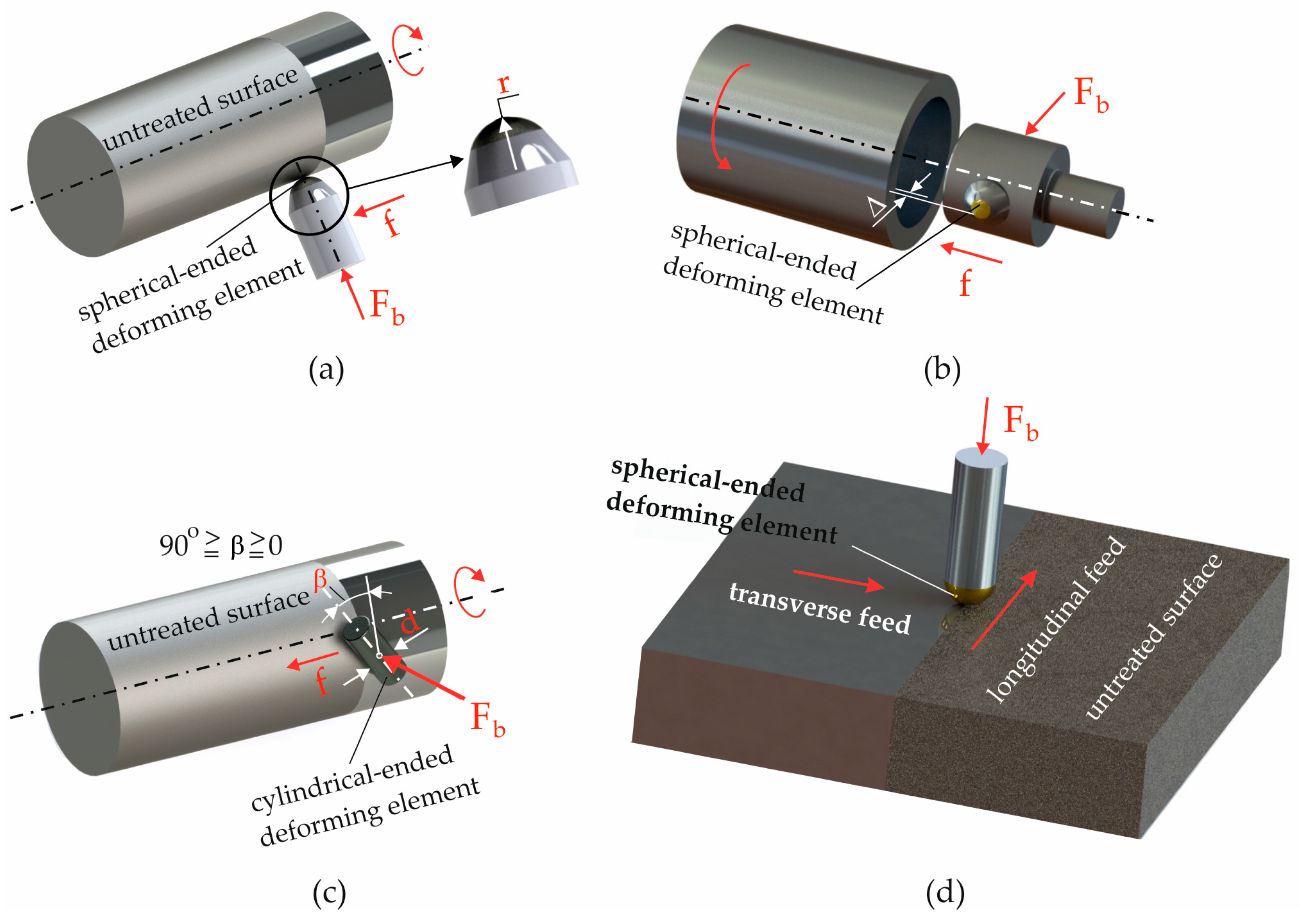

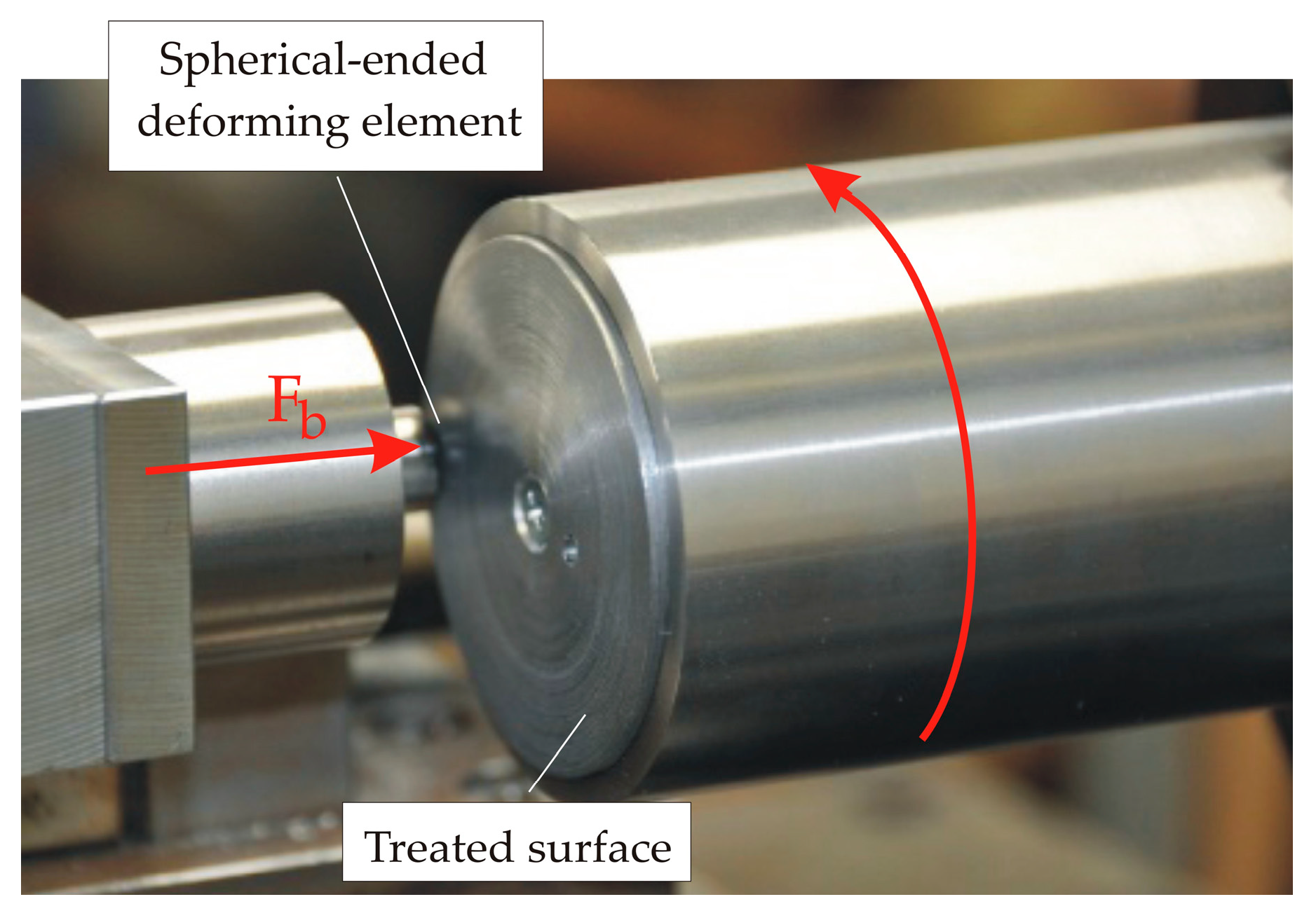


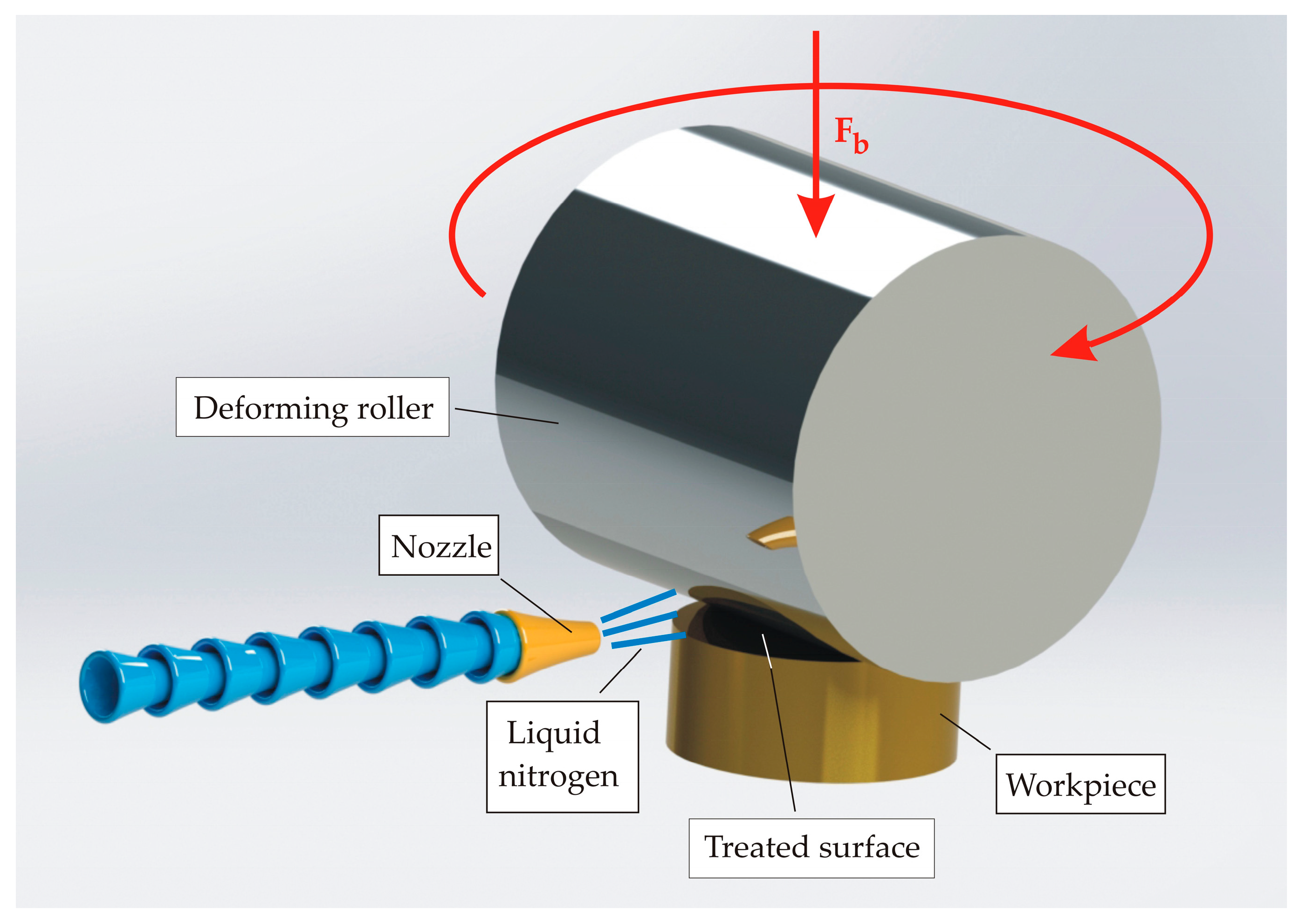
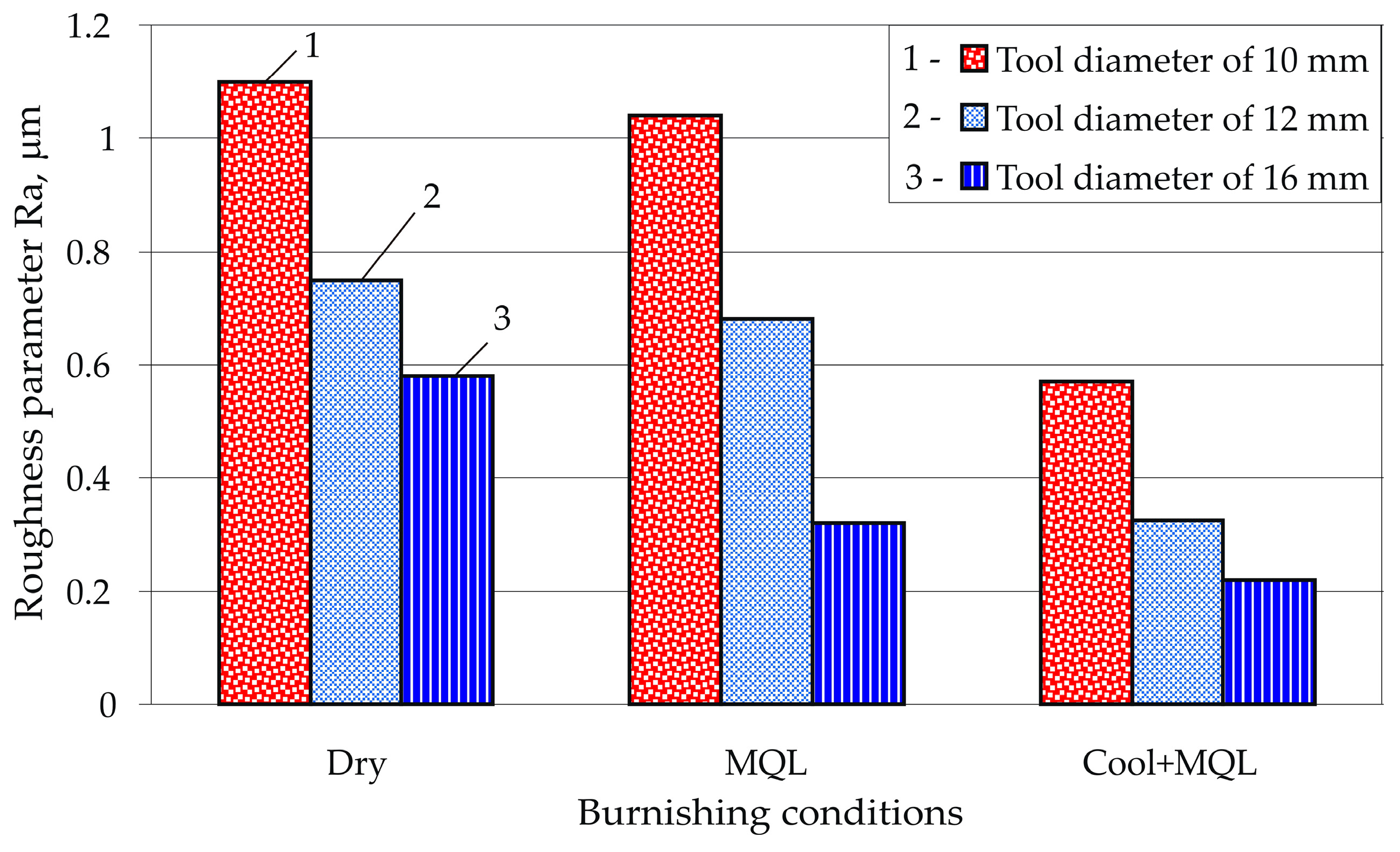
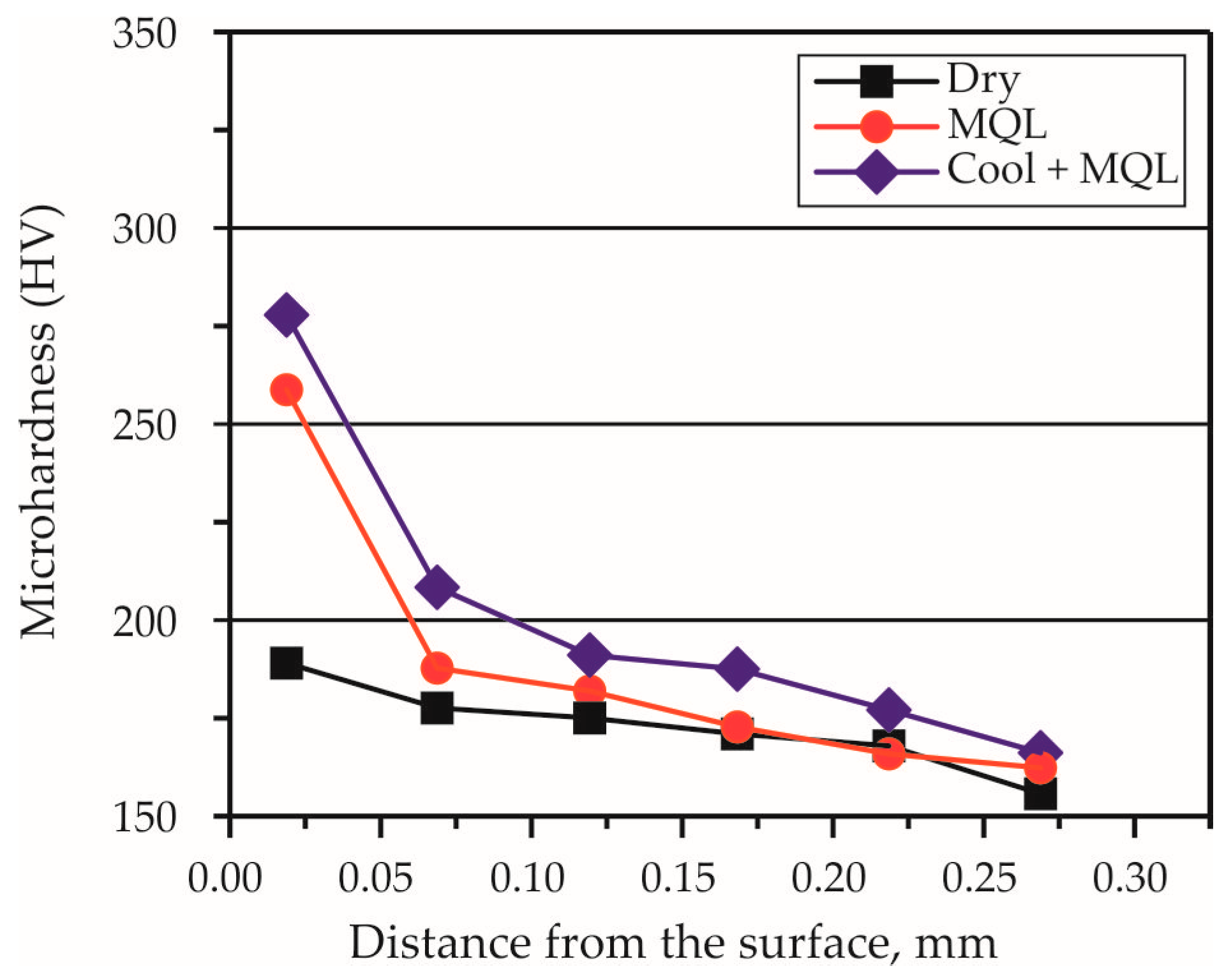
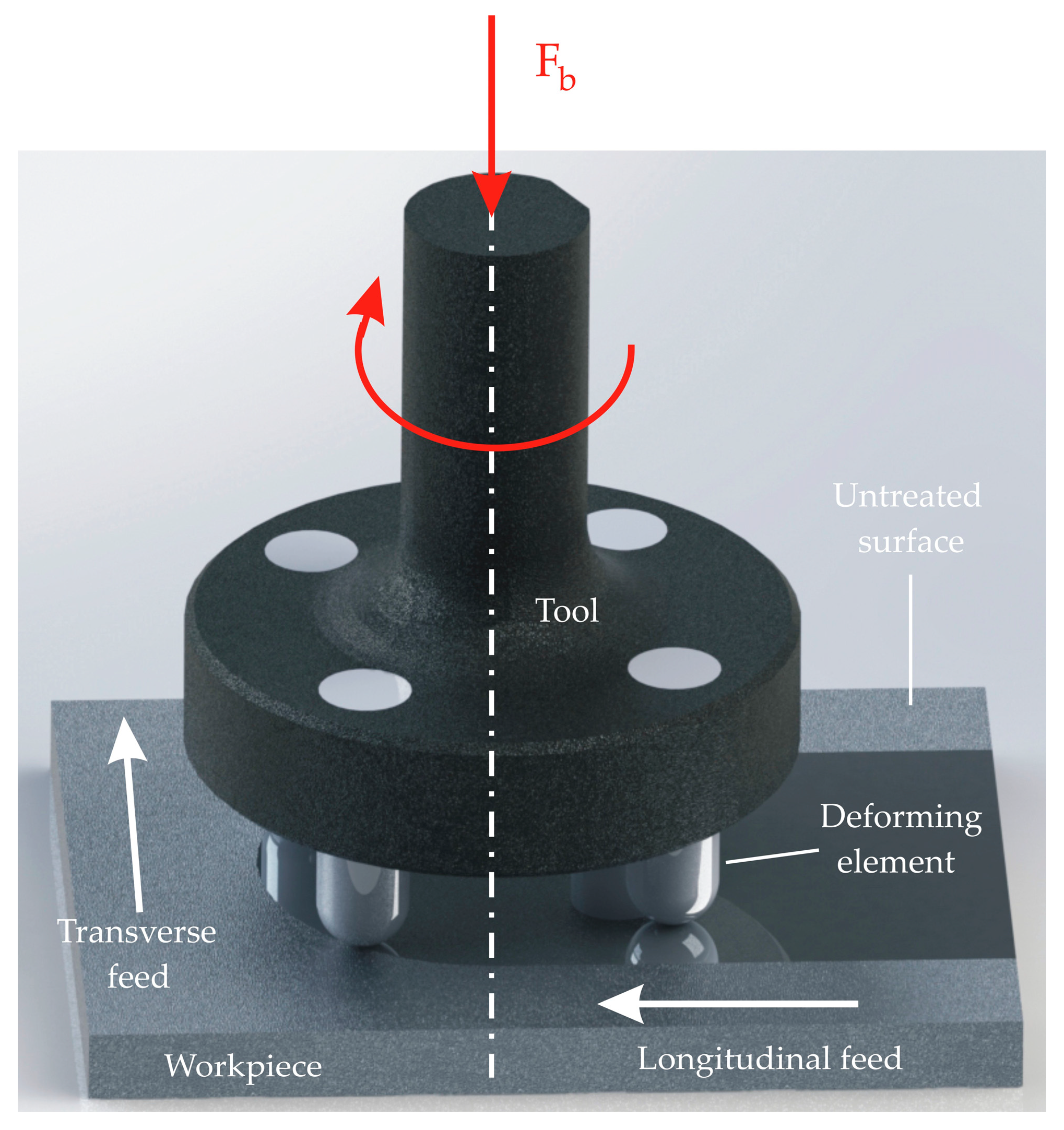

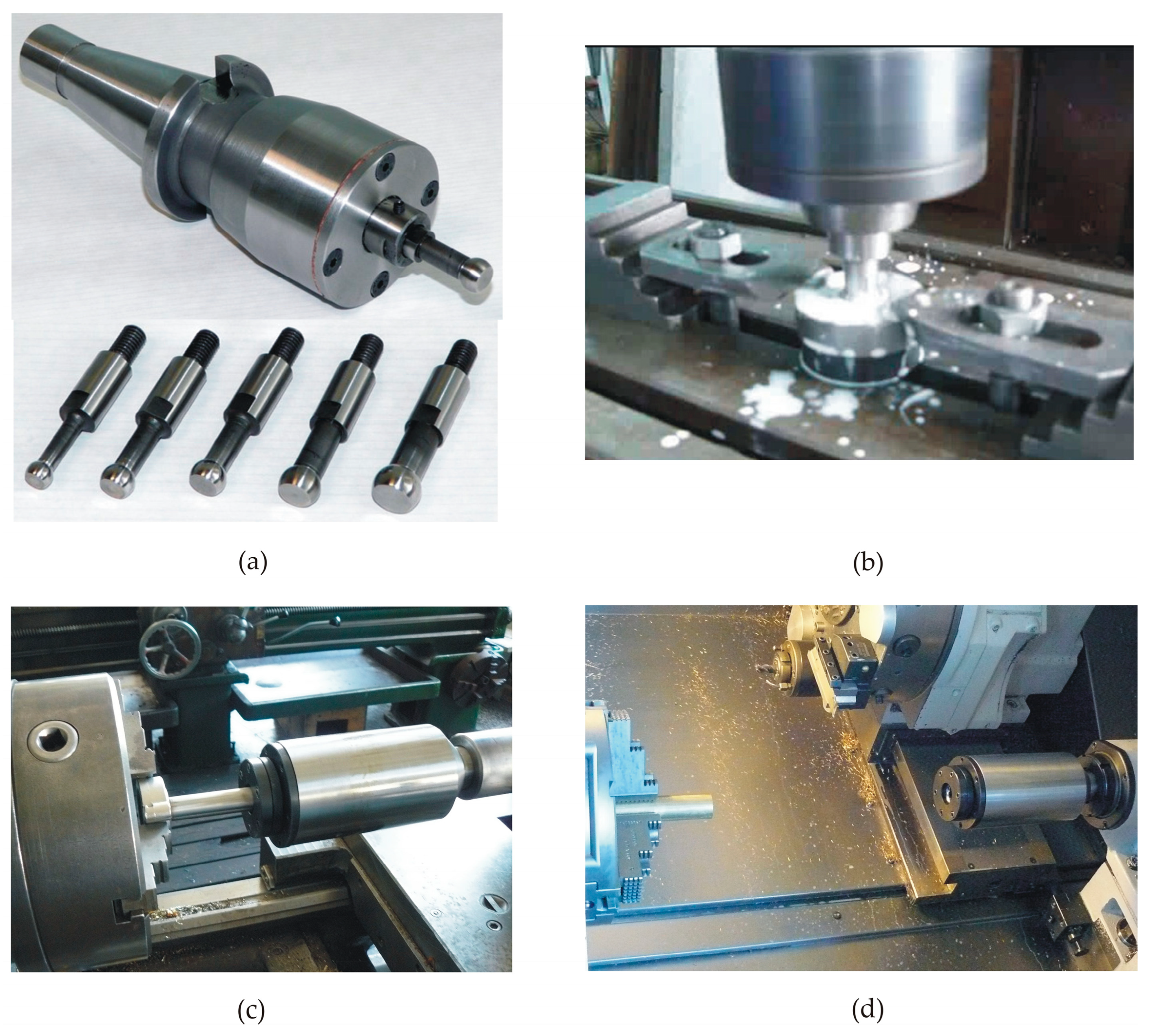



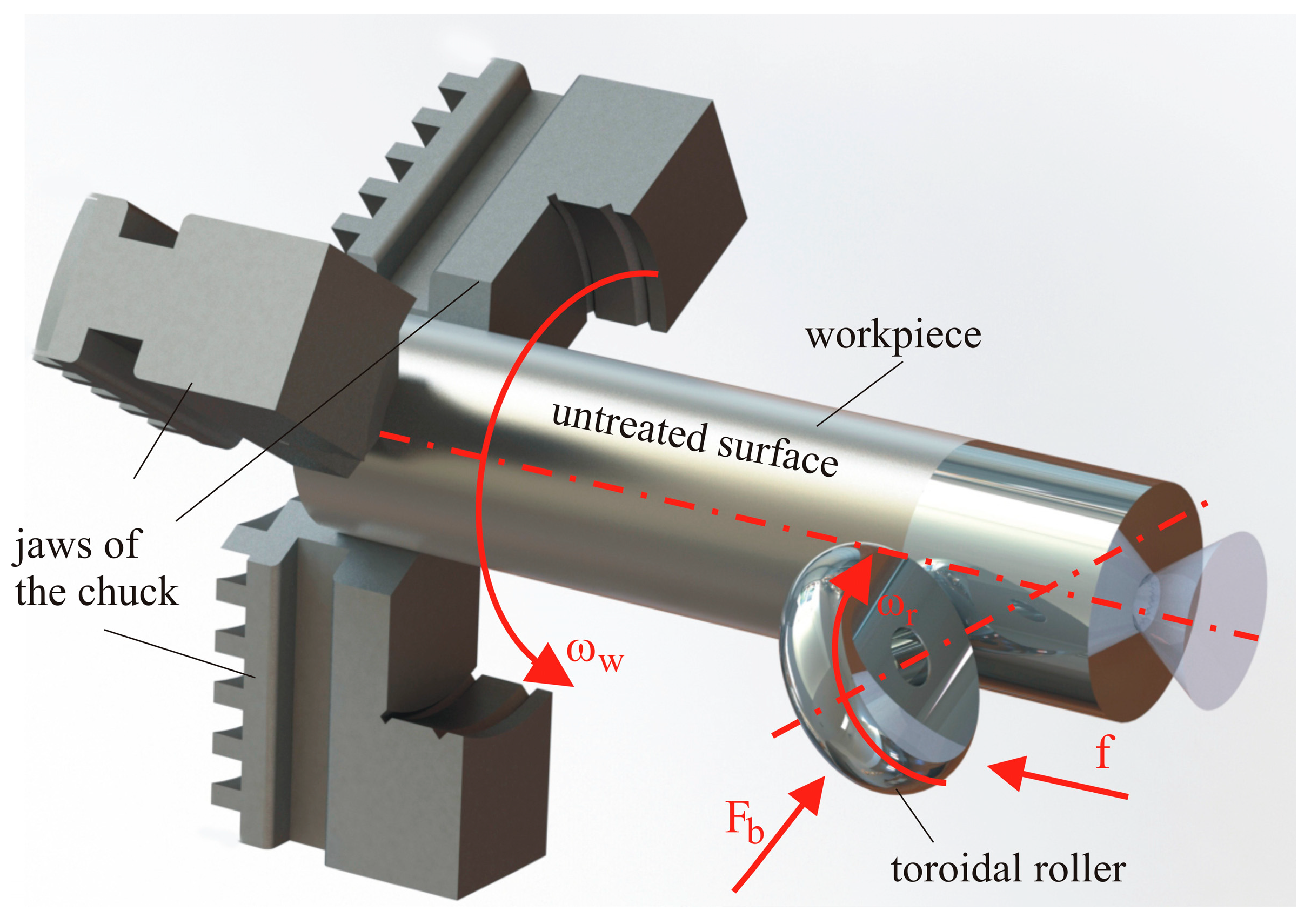

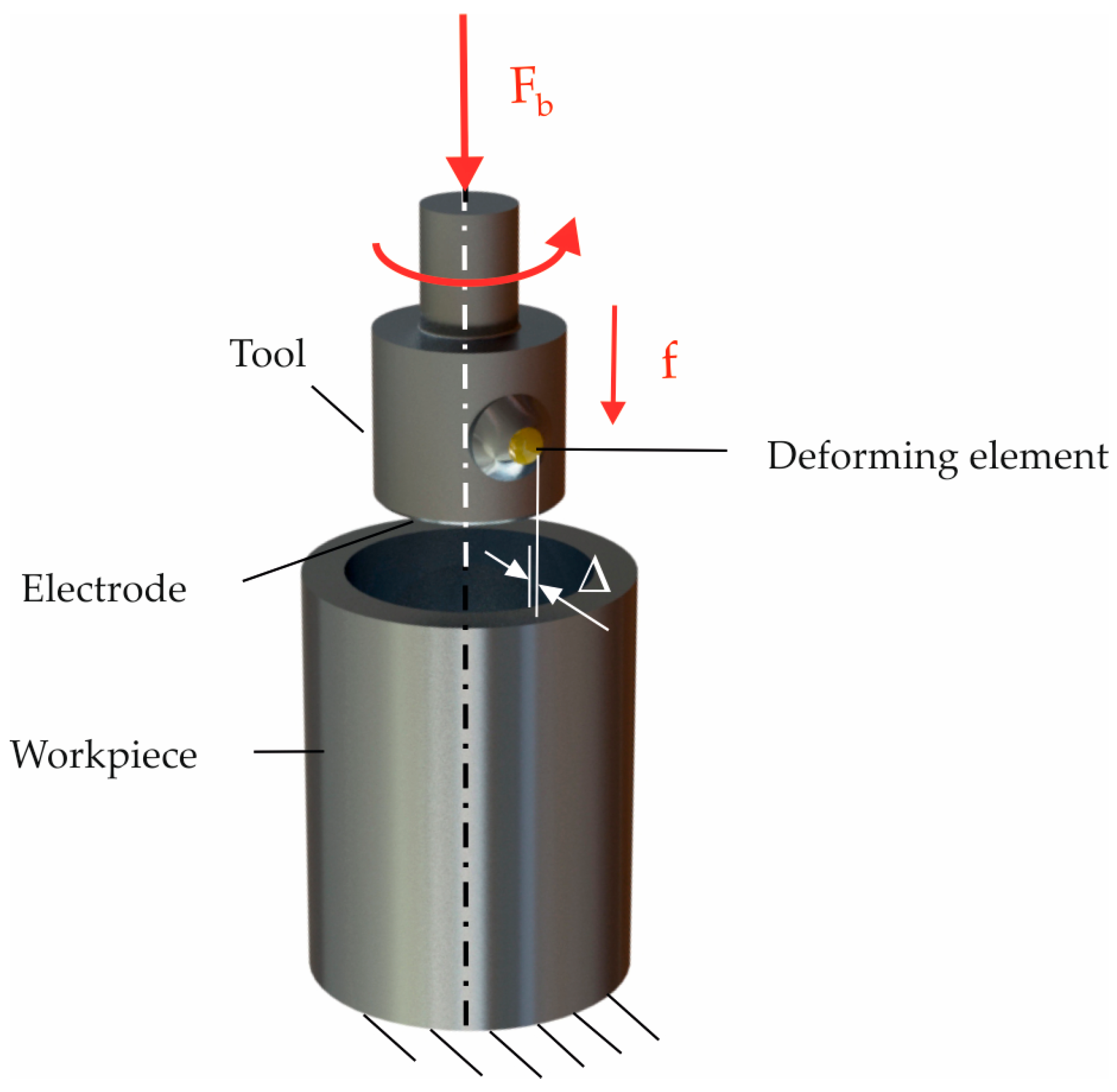

| Material Processed | Surface Processed | Deforming Element | SI Characteristics | Ref. | |||
|---|---|---|---|---|---|---|---|
| Shape | Material | Roughness, μm | Micro-Hardness | Residual Stress, MPa | |||
| AISI 1045 steel | External cylindrical | Cylindrical | WC | Rz = 0.27 | - | - | [23] |
| PDS5 tool steel | Flat | Spherical | Coated hardened steel; WC; | Ra = 0.07 | - | - | [24] |
| 42CrMo4 steel | Flat | Spherical | ; SiC; WC | Sq = 0.117 | 404.2 HV | −376.1 | [25] |
| AISI 314L steel | Internal cylindrical | Cylindrical | Hardened steel | Ra = 0.08 | - | - | [26] |
| C35 steel | External cylindrical | Spherical | WC | Ra = 0.11 | - | - | [27] |
| 7075-T651 | Flat | Spherical | 52100 hardened steel | Ra = 0.053 | 270 HV | - | [28] |
| 7075-T651 | Flat | Spherical | 52100 hardened steel | Ra = 0.087 | 270 HV | - | [29] |
| Material Processed | Surface Processed | Deforming Element | SI Characteristics | Ref. | |||
|---|---|---|---|---|---|---|---|
| Shape | Material | Roughness, μm | Micro-Hardness | Residual Stress, MPa | |||
| AZ91D magnesium alloy | External cylindrical | Spherical | Hardened AISI 52100 steel | Ra = 0.336 | 102 HV | - | [32] |
| 7075 aluminium alloy | External cylindrical | Spherical | “Hard alloy” | Ra = 0.08 | 210 HV | - | [33] |
| Normalised medium carbon steel | Flat | Spherical | ceramic | Ra = 0.2 | 567 HV | - | [35] |
| Hardened AISI 52100 steel | Flat | Cylindrical | Cubic boron nitride | Ra = 0.12 | 1537 HV | - | [37] |
| SS400 carbon steel | Flat | Flat | WC grade K10 | Ra = 0.58 * | - | - | [39] |
| Ra = 0.75 ** | [40] | ||||||
| Ra = 1.10 *** | [39] | ||||||
| Material Processed | Surface Processed | Deforming Element | SI Characteristics | Ref. | |||
|---|---|---|---|---|---|---|---|
| Shape | Material | Roughness, μm | Micro-Hardness | Residual Stress, MPa | |||
| AZ31B-O Mg alloy | External cylindrical | Cylindrical | M2/M7 high-speed tool steel | Ra = 0.225 | 1.35 GPa | - | [41,42,44] |
| - | - | +21 (hoop) −12 (axial) | [43,44] | ||||
| Thermal spray coating WC-10Co-4Cr | Flat | Cylindrical | Carbide-based | Ra = 0.84 | more than 30% increase | −191.4 (longitu-dinal) −205.4 (transverse) | [45] |
| Ti-6Al-4V alloy | External cylindrical | Cylindrical | Cemented carbide | Ra = 0.32 | - | - | [46,47] |
| AZ31B-O Mg alloy | External cylindrical | Cylindrical | M2/M7 high-speed tool steel | Ra = 0.58 | 95% increase | - | [48] |
| Co-Cr-Mo alloy | 40% decrease in Ra | 80% increase | - | [48,49,50,51,54] | |||
| Flat | Ra = 0.2 | - | −100 (hoop) −1200 (axial) | [52] | |||
| Material Processed | Surface Processed | Deforming Element | SI Characteristics | Ref. | |||
|---|---|---|---|---|---|---|---|
| Shape | Material | Roughness, μm | Micro-Hardness | Residual Stress, MPa | |||
| MQL-assisted SB | |||||||
| SS400 carbon steel | Flat | Flat | WC grade K10 | Ra = 0.32 * | - | - | [39] |
| Ra = 0.68 ** | [40] | ||||||
| Ra = 1.04 *** | [39] | ||||||
| WE 43 Mg alloy | External cylindrical | Spherical | Hardened AISI 52100 steel | Ra = 0.187 | 109.4 HV | [55] | |
| Cool + MQL-assisted SB | |||||||
| SS400 carbon steel | Flat | Flat | WC grade K10 | Ra = 0.22 * | - | - | [39] |
| Ra = 0.325 ** | [40] | ||||||
| Ra = 0.57 *** | [39] | ||||||
| Material Processed | Surface Processed | Deforming Element | SI Characteristics | Ref. | |||
|---|---|---|---|---|---|---|---|
| Shape | Material | Roughness, μm | Micro-Hardness | Residual Stress, MPa | |||
| 1050A aluminium | Flat | Spherical | Hardened steel 62-65 HRC | Ra = 0.68 | 43 HV | −45 | [56] |
| 37Cr4 steel | External cylindrical | Toroidal | Ferro-tic Grade C | Ra = 0.235 | - | −700 | [57] |
| Ra = 0.30 | 360 HV | −700 | [59] | ||||
| Ni-based alloy | Flat | Spherical | Diamond-like-carbon-coated carbide | Ra = 0.1 or less | - | - | [60] |
| Martensitic stainless steel | Flat | Spherical | WC with DLC coating | Ra = 0.024 | - | - | [61] |
| Oxygen-free copper 101 | Flat | Spherical | WC; Silicon nitride ) | Ra = 0.183 | - | - | [62] |
| 2024-T3 Al alloy | Cylindrical hole | K-profile | Hardened tool steel | Ra = 0.417 | - | - | [63] |
| AISI 316 stainless steel | External cylindrical | Toroidal | 1.3343 hardened high-speed tool steel (63 HRC) | Ra = 0.063 | 430 HV | −300 (axial) | [64] |
| AISI 304 stainless steel | Ra = 0.055 | 450 HV | −300 (axial) | [65] | |||
| SUS420J2 stainless steel | External cylindrical | Spherical | WC | Ra = 0.025 | Increase by 3% | −1030 (axial) | [66] |
| Material Processed | Surface Processed | Deforming Element | SI Characteristics | Ref. | |||
|---|---|---|---|---|---|---|---|
| Shape | Material | Roughness, μm | Micro-Hardness | Residual Stress, MPa | |||
| 34CrNiMo6-M tempered steel (1) 330 HV | External cylindrical | Spherical | WC | Ra = 0.10 | 347 HV | −1200 | [67] |
| (2) 410 HV | Ra = 0.11 | 456 HV | −800 | ||||
| 6061-T6 | Flat | Spherical | Hardened steel | Ra = 0.12 | 202.8 HV | - | [68] |
| Austenitic stainless steel | Rotary | Spherical | Cemented carbide | Ra = 0.063 | 505 HV | −550 | [69] |
| C45 steel coated with cobalt sate-llite layer | Flat | Spherical | Sintered carbide | - | 800 HV0.02 | −600 | [70] |
| Characteristic | Variants | Reference |
|---|---|---|
| A. Dimension of the FE model | A.1. Two-dimensional plane strain | [37,57] |
| A.2. Two-dimensional plane stress | - | |
| A.3. Two-dimensional plane (not specified) | [53] | |
| A.4. 3D | [63,68,69] | |
| B. Deforming element model | B.1. Rigid (analytical; discrete; heat conducting) | [37,53,57,63,69] |
| B.2. Deformable solid | [68] | |
| C. Processed surface in 3D models | C.1. Outer cylindrical | - |
| C.2. Inner cylindrical (hole) | [63] | |
| C.3. Flat | [68,69] | |
| D. Deforming element surface in 3D models | D.1. Idealised surface | [63,68,69] |
| D.2. Scanned real roughness | - | |
| E. Tool movement relative to the workpiece | E.1 Normal loading–unloading–moving with magnitude equal to feed rate | - |
| E.2. Two-dimensional sliding (in a straight line) | [37,53] | |
| E.3. Two-dimensional translation + rotation | [57] | |
| E.4. Three-dimensional sliding (on a plane) | [68,69] | |
| E.5. Three-dimensional sliding (on a cylindrical surface in the circumferential direction) | [63] | |
| F. Modelling of the initial roughness | F. 1. Kinematic roughness | [57,63] |
| F.2. Scanned real roughness | - | |
| F.3. Initial roughness not defined | [37,53,68] | |
| F.4. It is not specified | [69] | |
| G. Type of the FE analysis | G.1. Temperature-independent | [57,63,69] |
| G.2. Fully coupled thermal stress | - | |
| G.3. No fully coupled thermal stress | [37,53,68] |
| Characteristic | Variants | Reference |
|---|---|---|
| A. Obtained on the basis of: | A.1. Indentation test and inverse FE simulations | [57] |
| A.2. One-dimensional test of the bulk material | [63] | |
| A.3. From the literature | [37,68] | |
| A.4. Others | [53] | |
| A.5. It is not specified | [69] | |
| B. Type of the constitutive model | B.1. Rate-independent | [57,63] |
| B.2. Temperature-independent | [57,63] | |
| B.3. Rate-dependent | [37,53,68] | |
| B.4. Temperature-dependent | [37,53,68] | |
| B.5. It is not specified | [69] | |
| C. Strain hardening | C.1. Isotropic | [37,53,68,69] |
| C.2. Nonlinear kinematic | [63] | |
| C.3. Nonlinear isotropic/kinematic | [57] |
Disclaimer/Publisher’s Note: The statements, opinions and data contained in all publications are solely those of the individual author(s) and contributor(s) and not of MDPI and/or the editor(s). MDPI and/or the editor(s) disclaim responsibility for any injury to people or property resulting from any ideas, methods, instructions or products referred to in the content. |
© 2025 by the authors. Licensee MDPI, Basel, Switzerland. This article is an open access article distributed under the terms and conditions of the Creative Commons Attribution (CC BY) license (https://creativecommons.org/licenses/by/4.0/).
Share and Cite
Maximov, J.; Duncheva, G. Improvements in the Surface Integrity and Operating Behaviour of Metal Components Through Slide Burnishing with Non-Diamond-Based Deforming Elements: Review and Perspectives. Appl. Sci. 2025, 15, 12182. https://doi.org/10.3390/app152212182
Maximov J, Duncheva G. Improvements in the Surface Integrity and Operating Behaviour of Metal Components Through Slide Burnishing with Non-Diamond-Based Deforming Elements: Review and Perspectives. Applied Sciences. 2025; 15(22):12182. https://doi.org/10.3390/app152212182
Chicago/Turabian StyleMaximov, Jordan, and Galya Duncheva. 2025. "Improvements in the Surface Integrity and Operating Behaviour of Metal Components Through Slide Burnishing with Non-Diamond-Based Deforming Elements: Review and Perspectives" Applied Sciences 15, no. 22: 12182. https://doi.org/10.3390/app152212182
APA StyleMaximov, J., & Duncheva, G. (2025). Improvements in the Surface Integrity and Operating Behaviour of Metal Components Through Slide Burnishing with Non-Diamond-Based Deforming Elements: Review and Perspectives. Applied Sciences, 15(22), 12182. https://doi.org/10.3390/app152212182










